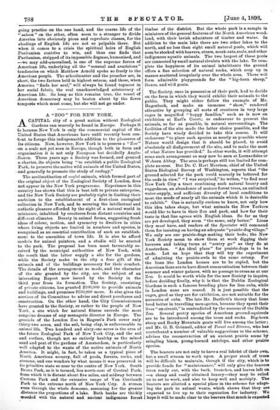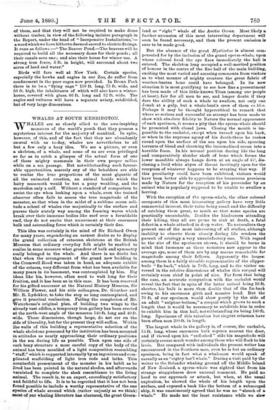A " ZOO " FOR NEW YORK.
ACAPITAL city of a great nation without Zoological Gardena can scarcely be found in Europe. Perhaps it is because New York is only the commercial capital of the I...Inked States that Americans have until recently been con- tent to forego this indispensable addition to the pleasures of its citizens. Now, however, New York is to possess a " Zoo " -on a scale not yet seen in Europe, though both in form and organisation it is not only European but decidedly Anglo- -Saxon. Three years ago a Society was formed, and granted a charter, its objects being "to establish a public Zoological Park, to preserve the native wild animals of the United States, . and generally to promote the study of zoology."
The acclimatisation of 'useful animals, which formed part of the original object of the Zoological Society of London, does not appear in the New York programme. Experience in this • country has shown that this is best left to private enterprise, and the New York Society are probably right in limiting their ambition to the establishment of a first-class zoological collection in New York, and to securing the intellectual and 4:esthetic pleasure afforded by the sight of a natural world in miniature, inhabited by creatures from distant countries and different climates. Beauty in animal forms, suggesting fresh ideas of colour, motion, and symmetry to dwellers in cities where living objects are limited in numbers and species, is recognised as an essential contribution of such an establish- ment to the amenities of town life. It is also to afford models for animal painters, and a studio will be erected to the park. The proposal has been most favourably re- ceived by the municipal authorities of New York, with the result that the latter supply a site for the gardens, while the Society make to the city a free gift of the animals and of the buildings necessary for their comfort. The details of the arrangement so made, and the character of the site granted by the city, are the subject of an iateresting Report now issued by the Society in the third year from its formation. The Society, consisting of private citizens, has granted $100,000 to provide animals and buildings, and promises $150,000 more. It also gives the services of its Committee to advise and direct purchases and construction. On the other hand, the City Commissioners have granted to the Society, or rather to the people of New York, a site which for natural fitness exceeds the most sanguine dreams of any menagerie director in Europe. The grounds of the London Zoo in Regent's Park cover only thirty-two acres, and the soil, being clay, is unfavourable to . animal life. Two hundred and sixty-one acres is the area of the future Zoological Park of New York City, and the soil and surface, though not so entirely healthy as the mixed sand and peat of the gardens of Amsterdam, is particularly well adapted to the wants of the native animals of North America. It might, in fact, be taken as a typical piece of North American scenery, full of pools, forests, rocks, and streams, and one wonders by what means it was preserved in its primitive state so near to the centre of New York. South Bronx Park, as it is termed, lies north-east of Central Park, from which it is distant about five miles, and midway between Crotona Park and the extensive range of Van Cortlandt Park to the extreme north of New York City. A stream runs through the whole demesne, assuming for the greater distance the proportions of a lake. Both banks are thickly .svooded with the natural and ancient indigenous forest
timber of the district. But the whole park is a sample in miniature of the general features of the North American wood. land, with their lavish admixture of timber and water. In addition to the main lake there are two other lakes to the north, and no less than eight small natural pools, which will soon be stocked with beavers, otters, musk-rats, seals, and other indigenous aquatic animals. The two largest of these pools are connected by small natural rivulets with the lake. To com- plete the happiness of its animal inhabitants the ground offers a fine selection of natural rocks, which crop up in masses scattered irregularly over the whole area. These will form admirable playgrounds for the "big-horn sheep," ibexes, and wild goats.
The Society, once in possession of their park, had to decide on the form in which they would exhibit their animals to the public. They might either follow the example of Mr. Hagenbeck, and make an immense "show," rendered attractive by grouping all sorts of creatures in very large cages in magnified "happy families," such as is now on exhibition at Earl's Court; or endeavour to present the animals, so far as possible, in natural surroundings. The facilities of the site made the latter choice possible, and the Society have wisely decided to take this course. It will endeavour "to place each species as nearly as possible where Nature would design that it should be placed, to avoid absolutely all disfigurement of the site, and to make the most of what Nature has provided." In other words, it will attempt some such arrangement as may now be seen at Leonardslee or Woburn Abbey. The area is perhaps still too limited for com- plete success. But Dr. C. Hart Merriam, chief of the United States Biological Survey of Washington, reports that "the ground selected for the park could scarcely be bettered for the ends in view." "I was surprised," he writes, "to find near New York City a tract combining such natural beauty and ruggedness, an abundance of mature forest trees, an unlimited water-supply, and sufficient diversity of local conditions to meet the needs of nearly all the animals which it is desirable to exhibit." One is naturally curious to know, not only how this idea takes shape, but what animals the New Yorkers would like to have in their Zoo and park, and how far their taste in that line agrees with English ideas. So far as they are yet developed, they seem "the same, only better." Lions they must have, and readers of the Spectator will commend them for insisting on having an adequate "prairie-dog village." We only see our prairie-dogs making their beds; the New York Society mean to show them at work digging their burrows and taking turns at "sentry go" as they do at Amsterdam. "An ideal place" for prairie-dogs is to be made. Let us hope that they will try the experiment of admitting the prairie-owls to the same colony. For the lions :the London houses are to be copied, but the American lions are to have direct communication between their summer and winter palaces, with no passage to cross as at our Zoo. It would be worth while for the new Society to inquire, before deciding finally, why it is that the Dublin Zoological Gardens is such a famous breeding place for lion cubs, while in London none are reared. It is just possible that the cages, good as they are for exhibition, are not suitable for the nurseries of cubs. The late Mr. Bartlett's theory that lions bred better in travelling menageries, because they spent their lives "on circuit," is contradicted by the success of the Dublin Zoo. Several pretty species of American ground-squirrels are to be introduced among the trees and rocks. Big-horn sheep and Rocky Mountain goats will live among the latter ; and Mr. G. B. Grinnell, editor of Forest and Stream, who has contributed a number of valuable suggestions to the scheme, advises the reconstruction of an ancient prairie scene by mingling bison, prong-horned antelope, and other prairie species.
The beavers are not only to have a real lakelet of their own, but a small stream to work upon. A proper stock of trees will be difficult to maintain, though if the city, which is to provide funds for "maintenance," will only give the beavers trees ready cut, with the bark, branches, and leaves left on —a cheap and easily obtained luxury—they may be relied on to set to work, and also to keep well and multiply. The beavers are allotted a special place in the scheme for adapt- ing the park to animal wants, which shows that they are expected to live up to their reputation for industry. We hope it will be made clear to the beavers that much is expected
of them, and that they will not be required to make dams without timber, in view of the following incisive paragraph in the Report, under the head of 'Inexpensive Installations,"— a word which we have hitherto deemed sacred to electric fittings. It runs as follows :—" The Beaver Pond.—The beavers will be required to build all the necessary dams for their ponds ; all their canals save one ; and also their house for winter use. A strong iron fence, 3 ft. in height, will surround about two acres of land and water."
Birds will fare well at New York. Certain species, especially the hawks and eagles in our Zoo, do suffer from confinement in the poor cages now provided. In Bronx Park there is to be a "flying cage" 150 ft. long, 75 ft. wide, and 50 ft. high, the inhabitants of which will also have a winter- house, covered with glass, 66 ft. long and 52 ft. wide. The eagles and vultures will have a separate aviary, subdivided, bat of very large dimensions.



































 Previous page
Previous page